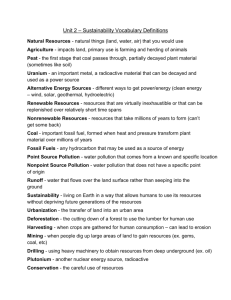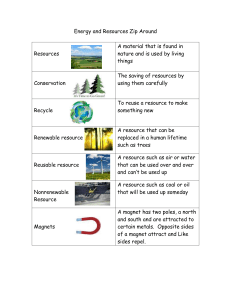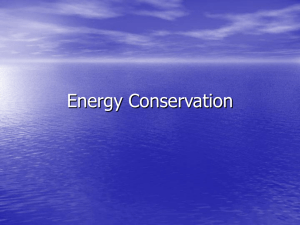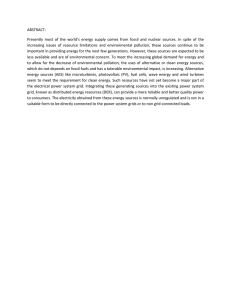Electricity & Environment: Pollution, Conservation, Sustainability
advertisement
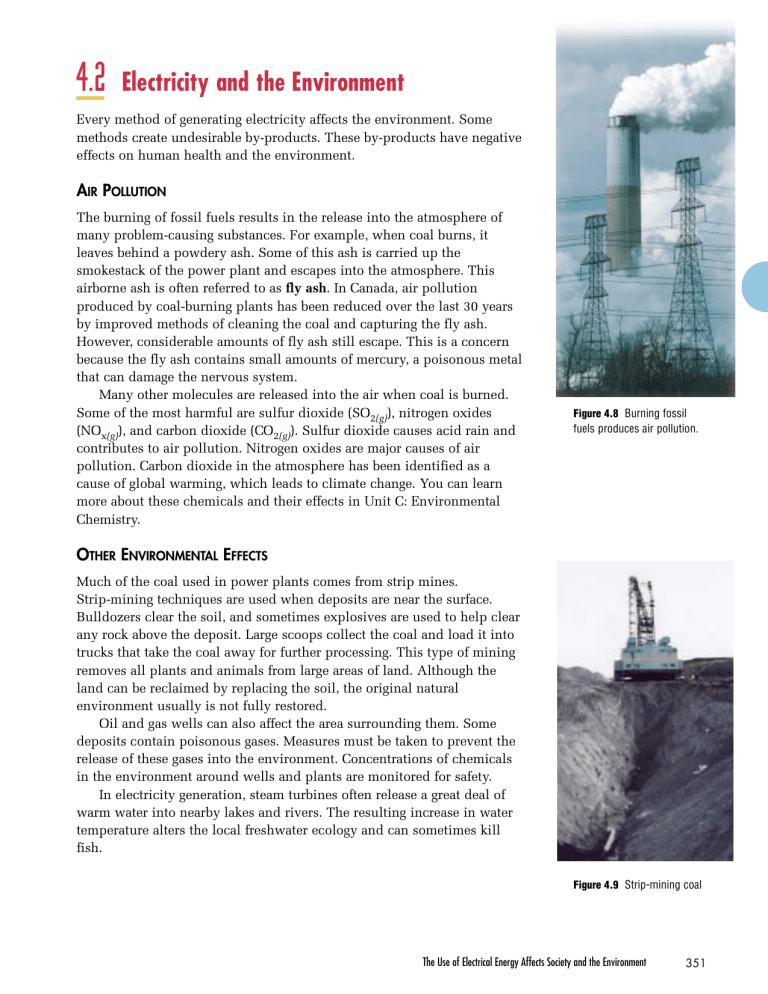
4.2 Electricity and the Environment Every method of generating electricity affects the environment. Some methods create undesirable by-products. These by-products have negative effects on human health and the environment. AIR POLLUTION The burning of fossil fuels results in the release into the atmosphere of many problem-causing substances. For example, when coal burns, it leaves behind a powdery ash. Some of this ash is carried up the smokestack of the power plant and escapes into the atmosphere. This airborne ash is often referred to as fly ash. In Canada, air pollution produced by coal-burning plants has been reduced over the last 30 years by improved methods of cleaning the coal and capturing the fly ash. However, considerable amounts of fly ash still escape. This is a concern because the fly ash contains small amounts of mercury, a poisonous metal that can damage the nervous system. Many other molecules are released into the air when coal is burned. Some of the most harmful are sulfur dioxide (SO2(g)), nitrogen oxides (NOx(g)), and carbon dioxide (CO2(g)). Sulfur dioxide causes acid rain and contributes to air pollution. Nitrogen oxides are major causes of air pollution. Carbon dioxide in the atmosphere has been identified as a cause of global warming, which leads to climate change. You can learn more about these chemicals and their effects in Unit C: Environmental Chemistry. Figure 4.8 Burning fossil fuels produces air pollution. OTHER ENVIRONMENTAL EFFECTS Much of the coal used in power plants comes from strip mines. Strip-mining techniques are used when deposits are near the surface. Bulldozers clear the soil, and sometimes explosives are used to help clear any rock above the deposit. Large scoops collect the coal and load it into trucks that take the coal away for further processing. This type of mining removes all plants and animals from large areas of land. Although the land can be reclaimed by replacing the soil, the original natural environment usually is not fully restored. Oil and gas wells can also affect the area surrounding them. Some deposits contain poisonous gases. Measures must be taken to prevent the release of these gases into the environment. Concentrations of chemicals in the environment around wells and plants are monitored for safety. In electricity generation, steam turbines often release a great deal of warm water into nearby lakes and rivers. The resulting increase in water temperature alters the local freshwater ecology and can sometimes kill fish. Figure 4.9 Strip-mining coal The Use of Electrical Energy Affects Society and the Environment 351 info BIT Nuclear Waste Storage Radioactive waste from nuclear power plants requires long-term storage. Canada’s plans for storing this waste include placing corrosion-resistant containers in vaults deep within the Canadian Shield. These vaults will be 500 to 1000 m deep and will likely be in Ontario. The mines and refineries that produce fuel for nuclear reactors can also damage the environment. The reactors create radioactive wastes that remain dangerous for thousands of years. Hydro-electric plants produce no pollutants, but their dams flood many hectares of land and alter the ecosystems of rivers. Wind farms and solar cell arrays require large tracts of land to generate practical amounts of energy. Also, the process for making solar cells creates some chemical pollution. The steam from geothermal plants produces a small amount of pollution. Generators using tidal or wave energy may disrupt the habitat for fish and other marine life. However, the “green” sources of energy—especially wind, tide, and geothermal—harm the environment much less than fossil fuels do. CONSERVING ENERGY NONRENEWABLE RESOURCES We know that reserves of oil and gas are decreasing, but it is likely that nonrenewable fossil-fuel supplies will last for your lifetime. So why bother trying to conserve energy? If demand for energy decreases, there is a lower demand for the resources that fuel electrical generating plants. Those pollution-producing plants that are already in operation would not need to operate at full capacity and may even be able to cease operation. The obvious benefit is less pollution, which is a good reason to try to use less electricity whenever possible. When your actions lead to a lower demand for natural resources, you are practising energy conservation. You may not have to worry about fossil fuels running out in your lifetime. However, even temporary shortages can cause hardship and big price jumps. When fuel prices skyrocket, poorer countries cannot afford the energy they need. Suppose you want to conserve fossil fuels and reduce pollution. You consider buying an electric car instead of one with a gasoline engine, but you know you have to look at more than just engine efficiency. Electric cars reduce the need for gasoline, which comes from oil. Burning less gasoline conserves oil reserves and reduces pollution. The electric car, however, must get electricity from somewhere for its rechargeable batteries. If a coal-fired plant supplies this electricity, you may not be saving fossil fuels or reducing pollution overall. However, if a hydroelectric plant or windmill farm supplies the electricity, fossil fuels will be conserved and pollution will decrease. Both personal and societal decisions must be taken into account when considering conservation. Figure 4.10 Does an electric vehicle conserve energy resources? 352 AND Unit D: Electrical Principles and Technologies A SUSTAINABLE FUTURE Conserving energy means moving toward sustainability. Sustainability means using resources at a rate that can be maintained indefinitely. If we do not achieve sustainable energy use, future generations may not be able to support themselves. A sustainable approach sometimes requires a different way of developing resources. In the past, mineral and hydrocarbon deposits were used up as quickly as possible to earn money and satisfy consumer demand. We need to use our resources in a way that makes them available over a longer period. Sustainability may also mean no longer using nonrenewable resources because they cannot be maintained indefinitely. We may never be able to achieve complete sustainability, but the decisions we make personally and as a society can move us closer to this goal. An example of a personal decision would be to take public transportation rather than driving your own vehicle. This saves fuel and reduces pollution. Decisions made with sustainability in mind sometimes involve compromise—a bus may not be as convenient as your own car. An example of a societal decision related to sustainability is the use of low wattage street lights. Some cities have installed these lights to reduce electricity consumption and light pollution. In this case, the drawback is that streets may not be as brightly lit. CHECK AND re SEARCH Acid Mine Drainage The environmental effects of using coal start with its removal from the ground. The water that flows through mines and coal storage areas can become acidic. It may also contain dissolved metals. Research acid mine drainage. Prepare a brief report on its environmental effects and what is being done to reduce those effects. Start your search at www.pearsoned.ca/ scienceinaction. REFLECT Key Concept Review 1. How can oil wells affect the environment? 2. Do nuclear power plants produce by- products? If so, are they harmful? 3. What is fly ash? Why is it an environmental concern? 4. Explain why you agree or disagree with the following statement. “Green” sources of energy such as solar and wind power have no environmental impact. Connect Your Understanding 5. What is the difference between energy conservation and energy sustainability? 6. Does replacing the soil removed by strip- mining restore the environment? Explain your answer. 7. Explain how each of the following actions affect energy sustainability: a) replacing a coal-fired power plant with several fields of solar arrays b) choosing a new refrigerator that is high efficiency c) carpooling with friends to drive to work d) replacing the incandescent bulbs in your home with compact fluorescent bulbs Extend Your Understanding 8. A friend brags to you about her new electric car that uses rechargeable batteries as an energy source. She says, “My new car doesn’t have an internal combustion engine, so no fossil fuels are needed to provide energy for it.” Is this an accurate statement? Explain your answer. 9. In 1906, many steam-powered cars were on the roads. The record for the fastest steam car was approximately 206 km/h. A British team is now working to build a modern steam car that it hopes will travel over 300 km/h. While this car will be fast, will it conserve energy? Explain. The Use of Electrical Energy Affects Society and the Environment 353
